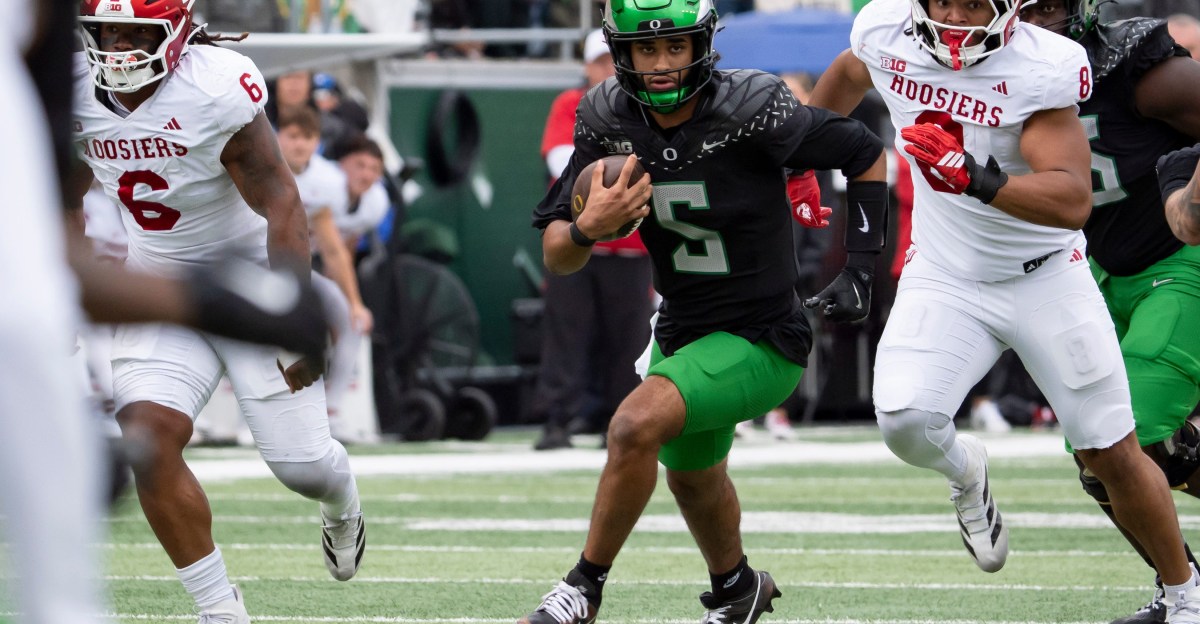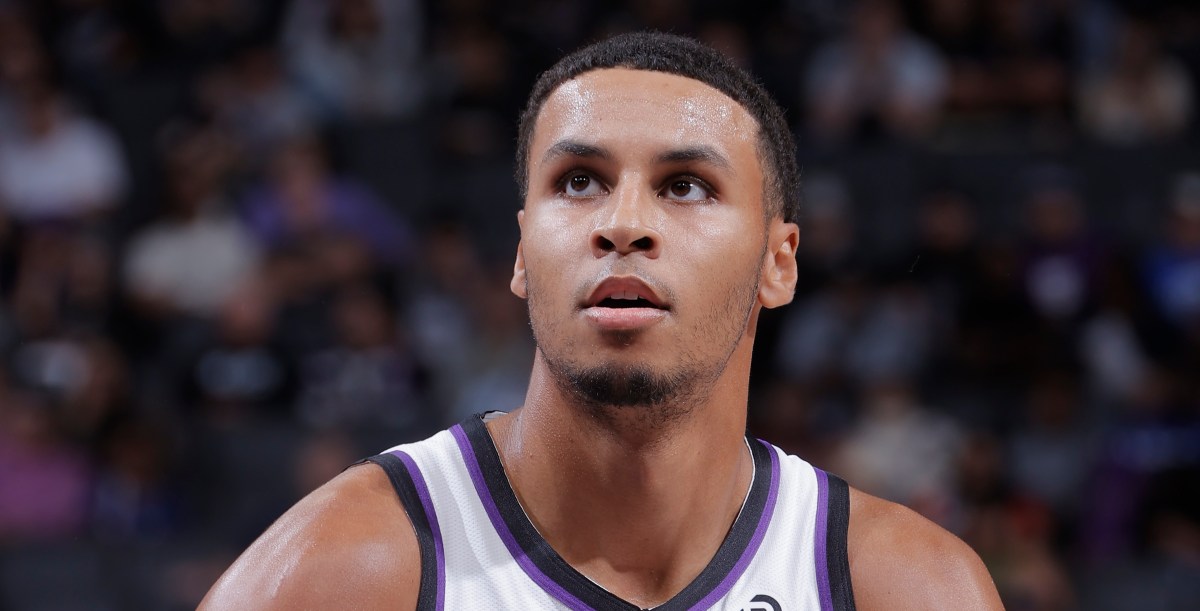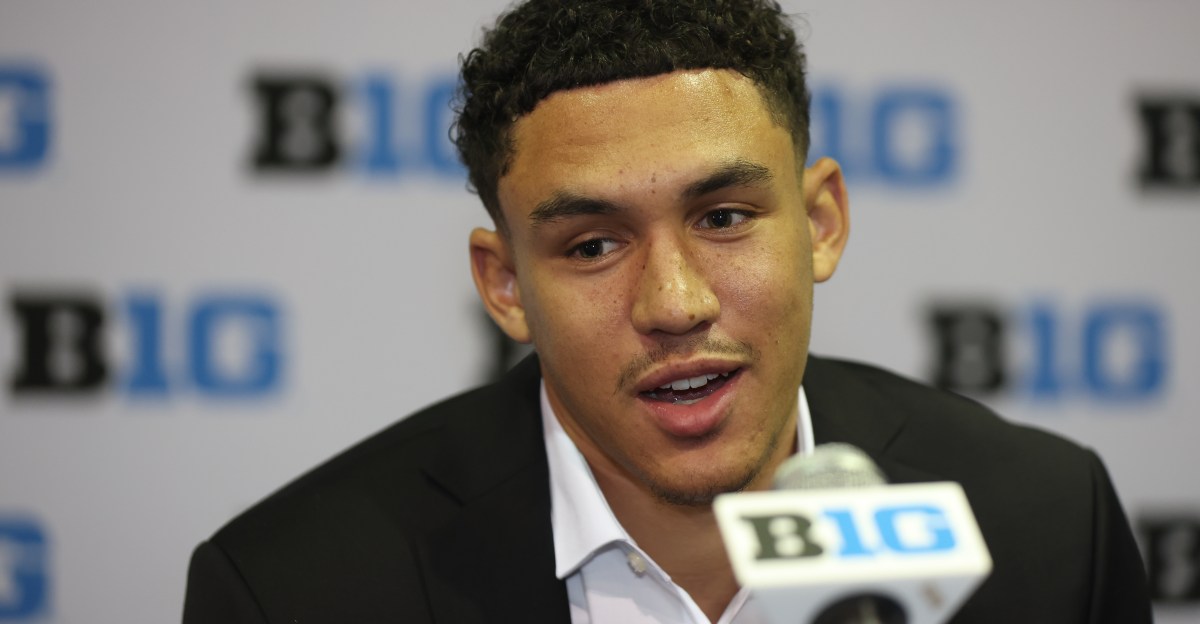Duck Tape: Film Review of Oregon vs Indiana
The end of the first half of this game ended up having a major effect on the end of the fourth quarter. Oregon’s short missed field goal led to a quick drive to try and set up a long field goal attempt (tallied separately since the game clock situation meant play calling was non-representative) that allowed the Hoosiers to salt the game away with a 10 point lead late in the fourth.
The first interception thrown by QB #5 Dante Moore with about six minutes left in the 4th quarter effectively ended the game and rendered the final two possessions by both teams garbage time – Indiana was already up 7 points and took over within field goal range, so their playcalling changed as the outcome of the drive was foreclosed and had rendered subsequent drives irrelevant to the game state.
Editor’s note: ATQ has acquired film from alternate angles of the game, though not in time for video processing to include in first publication. Additional clips will be added to the compilations in this article later today.
Play Type |
Plays |
Success Rate |
Explosive Rate |
Adj. YPP |
|---|---|---|---|---|
| Rush | 23 | 60.87% | 4.35% | 5.04 |
| Pass | 35 | 28.57% | 8.57% | 6.20 |
| Total | 58 | 41.38% | 6.90% | 5.65 |
The Ducks had one of the worst overall offensive performances of the Lanning era in this game, only being above water in efficiency rushing offense. Of ten drives outside of garbage time only three went more than 40 yards and the only touchdown came on the one deep pass completion of the game. Favorable field position on a fourth drive led to a total of three field goal attempts, but one was missed.
I’ll break down the details in each section as I go, but in summary I attribute the offensive struggles to three primary factors.
- The ongoing issues with the offensive line did not show much improvement from previous games. The run blocking error rate was comparable to the 2025 season average from before the bye. The pass blocking rate did improve a couple of points, but at just over 15% across all drop backs it was still below the FBS average.
- What had been pressures or scrambles in prior weeks became sacks and throwaways on Saturday because Moore was hesitant to throw the ball. From the broadcast angles it is difficult to tell how much of this was Indiana’s coverage taking away his first and second read. As a second year starter, at least part of it may have simply been him having a bad day at the office.
- This was one of OC Will Stein’s least impressive game plans since he came to Eugene. Despite running the ball more efficiently the play calling emphasized passing. I did not see any concerted effort to attack the potential vulnerabilities in the Hoosier’s coverage to the fieldside that ATQ’s preview had identified.
In the running game most plays seemed to target the interior (A and B gaps) or off tackle (C gaps). While most of Oregon’s ball carriers were extremely efficient, only #0 Jordan Davison managed any explosive plays. His lateral agility allowed him to adjust on several plays when the blocking was being executed as drawn up and his strength let him bounce off tacklers for extra yardage. Below is a representative sample of successful rushing plays.
(Reminder: you can control the playback speed by using the gear icon in the lower right of the player.)
- :00 – This was the second attempt to convert fourth and short early in the game running the ball. A wide receiver, #1 Dak. Moore is lined up deep so the defense has to be ready for the offense to possibly try to get to the edge. Watch the double teams on the offense’s left. None of the blockers attempt to break off and reach the linebackers, trusting Davison to fall forward for a yard if he has a clean hole. It probably still would have worked even if the MIKE hadn’t inexplicably gone outside. This allowed Davison to run over the WILL for extra yardage.
- :15 – Davison shows off his vision and quick feet on this play. It looks like the run is designed to go to the B-gap between RG #74 Iuli and RT #75 Harkey. When TE #18 Sadiq loses control of his man Davison makes a little stutter step to his left behind Iuli where the DT and WILL have left an opening.
- :29 – This inside zone run to #27 Limar is also supposed to hit the B-gap on the offense’s right. Again interior penetration by a DE against the blocking TE, #9 Ja. Johnson this time, forces the runner to improvise. Limar bounces outside where the pass coverage has left plenty of space to work with.
- :41 – Notice WR #11 McClellan in almost an H-Back role as he takes on the corner to the offense’s left. He saw frequent use as an additional blocker in this game, though he was also targeted as a receiver. The run design might be to go off left tackle but Sadiq allows inside penetration and Harkey lets the backside pursuit free so RB #6 Whittington has to bounce out to his left. Solid blocks from LT #76 World and McClellan means he is still isolated on the deep safety and able to pick up 5 yards on 1st and 10.
The Hoosiers weren’t as efficient stopping the interior run game as they have been against other opponents this season, but without any explosive plays the Ducks weren’t going to be able to sustain drives on the ground. Indiana had seemed more vulnerable to perimeter runs earlier this season, but Oregon only went to the edge twice. Neither play was effectively sequenced with constraint plays as Indiana was prepared both times. Here is a sample of failed rushing plays.
- :00 – This was the first attempt to convert fourth and short. The blocking scheme out of the heavy I-formation (reserve OT #35 Wilson is lined up as a TE on the offense’s left) is more complex and this line just can’t get it done. Indiana has predicted the direction the run will go based off of the position of FB #44 Grace and slants towards the offenses left. Wilson lunges off balance out of his stance, Sadiq is beaten around the edge, and World’s pad level is too high. Davison has to cut back to his right where the unblocked SAM can wrap up his legs. At center #72 Laloulu has also lunged forward off balance and fallen down so the DT makes sure Davison cannot escape.
- :29 – Another unusual formation with World to the right of Iuli to the offense’s right where Harkey is lined up as a blocking TE (ineligible as a receiver, he’s covered) while Ja. Johnson is in the left tackle position. Indiana has adjusted by moving their D-line to the offense’s right and having the SAM play on the line of scrimmage across from the tight ends on the offense’s left. The fly-sweep action by Dak works perfectly, moving a defender away from the play and opening a hole for Davison. World can’t get to the second level quickly enough and Davison is tripped up before he can cut back under the block of WR #2 Bryant.
- :35 – The Hoosiers kept their three linebackers on the field whenever Oregon was in either 12 or 21 personnel, as they are here with Davison offset and #23 Hill in the pistol. I would have liked to see the TEs and/or backs split out in motion to isolate the backers in coverage but never saw this adjustment during the game. Ideally this perimeter run would have been sequenced so the safety IU #1 Ferrell wouldn’t expect a run, but he does. Davison is too hesitant, he needs to aggressively attack the outside shoulder to give Hill a chance to turn the corner and escape the SAM.
- :49 – It’s never a good sign when the defenders are pointing toward where the play is headed before the snap. The corner is engulfed by LG #75 Pregnon, but Laloulu misses the WILL and Davison whiffs on the MIKE. To cap it all off Ja. Johnson loses outside contain on the DE who assists with the tackle. The Ducks never got Hill to the edge, he had by far his least productive game of the season so far.
Both due to inclination and the offensive line situation, most of the passing game was oriented around Dante Moore getting the ball out quickly to this first or second read. In this game, these early reads tended toward the boundary, where Indiana’s coverage has been much stronger this year. Below is a sample of successful passing plays.
- :00 – Oregon only called 4 screens in this game, a big departure from the plan against Penn State and below even the FBS average. Iuli trips over Harkey’s foot so Bryant has to escape the linebacker using only his speed. He expertly slaloms between the blocks of Whittington and Dak. Moore to keep the drive alive.
- :16 – This was one of the few times Stein deliberately attacked the field side coverage and it resulted in the best play of the game for Oregon’s offense. Indiana is caught blitzing against max protect from the Ducks, so all three wide receivers are single covered. The ball to WR #4 Benson is a bit underthrown, but the safety IU #1 Ferrell is confused in coverage as prior film study indicated was likely.
- :33 – There is some confusion on this RPO as Davison seems to be running to the wrong side. This leaves Dante Moore no choice but to try to throw even though the nickel is giving him a run read. However that same nickel overreacts to the outside, another film study tendency, and Dak is able to reach for the ball.
- :55 – Another success when the quarterback’s first read is to the field. Since that is where Moore will be looking, the offensive line is slanting the protection left and Moore has to deal with the free rusher himself. Since the linebacker isn’t dropping to defend the hitch to Bryant, Moore gets the ball out fast and lets the veteran do the rest.
At least in part due to Moore not having the confidence to throw quickly he was sacked 5 times. Indiana also did very well to contain his ability to scramble. Despite ATQ’s preview, I only saw one attempt to try to exploit the Hoosier’s field/boundary coverage structure by overloading 4 receivers to one side of the field (Moore rolled to his right and straight into a sack on the play). Here are some other examples of failed passing plays.
- :00 – Moore is looking into the boundary for a quicker throw. Sadiq is bracketed above and below, and though Benson is single covered the corner is in good position against a comeback route. Moore tries to squeeze the ball in but Benson slips. Even a catch would have been a yard short of the line to gain. I don’t know if the QB has the option to change the progression based on the coverage, but with the cushion the field corner is giving against Dak at the top of the screen it would be easier to hit him on an out-breaking route.
- :18 – Watch Iuli at right guard and Laloulu at center on this protection. Iuli sees the end/tackle stunt and correctly hands off the DE IU #8 as Harkey gives the looping DT #95 a shove to give Iuli time to rest. Laloulu needs to see the twist and immediately leave the linebacker to Pregnon to pick up the DE coming underneath. When he doesn’t Moore has pressure coming right up the middle and can only throw the ball away.
- :26 – Moore’s first read is a screen to Davison toward the boundary, but that is immediately taken away by the DE who has split out into coverage. Pressure is coming when the nickel blitzes, but there is room to step up in the pocket and move to his next read. He gets happy feet and breaks contain looking to run, eventually trying to squeeze in a pass to Sadiq that would have been an extremely impressive catch. If he had looked to Dak earlier, there was a throw to be made.
- :48 – Oregon goes back to the well with another screen to Bryant in the second half but the water has run dry. Had Indiana come with a blitz this could have worked but when IU #4 Fisher drops into coverage as a simulated pressure Pregnon cannot get to him in time.
Play Type |
Plays |
Success Rate |
Explosive Rate |
Adj. YPP |
|---|---|---|---|---|
| Rush | 23 | 47.83% | 8.70% | 4.00 |
| Pass | 33 | 48.48% | 12.12% | 7.14 |
| Total | 56 | 48.21% | 10.71% | 5.73 |
Oregon’s defense had a strong performance despite the final score. Indiana was held well below their typical performance in all metrics we track, and particularly struggled with gaining chunk yards on the ground. One of the Hoosier’s field goals came in the high variance end-of-half scenario, and the other two on short fields following Oregon turnovers (a failed 4th and 1 conversion and the first interception).
Indiana’s three touchdowns all came on long full field drives of the kind the Ducks’ defense has been vulnerable to so far this year. Of their other seven possessions outside of garbage time the longest moved only 27 yards. Even in the first quarter it was apparent that head coach Cignetti and his offensive staff had diversified the playbook from what they had used so far in Big Ten Play. All three touchdown drives featured calls that hadn’t appeared in prior film study of the offense so far this season. A lot of credit needs to go to Indiana’s coaches for installing these new plays and to their offensive players for executing them at a high level.
Oregon’s front held the advantage over Indiana’s run blockers most of the game. The Hoosiers’ backs showed the same strength to fall forward for extra yardage they had demonstrated prior this game. It was not usually enough to stay ahead of the chains, though. Below is a sample of successfully defending rushing plays.
- :00 – Indiana is running inside zone to the offense’s left, which has no chance when DT #1 Alexander beats the double team. The runner has to cut back to his right, but DT #52 Washington has kept his blocker at arms length so he can react, disengage, and make the tackle.
- :07 – This is the same play as before from a spread out formation. There is a blitz coming from LB #26 Jackson, but the play can still work as the back is running away from him. Washington goes under Alexander in a twist and occupies two blockers by himself, leaving Alexander free to make first contact. The rest of the defenders combine to prevent any second effort and force third down.
- :21 – The Hoosiers are in a two tight end set and Oregon has countered with bringing #9 Purchase on a second OLB. Indiana passes out of this set more often than they run, but the Ducks aren’t caught by surprise. Coming on a blitz #28 Boettcher wrong arms the H-back while Alexander cuts under both the right tackle and pulling guard to throw the ball carrier for a loss.
- :27 – Indiana tries to run outside zone toward the boundary, away from the linebackers who have shaded toward the field because of their pass coverage responsibilities. Washington and OLB #44 Tuioti both get their helmets playside so the runner has to cut back toward where the rest of the defenders are. Alexander doesn’t allow a free release from the guard so Boettcher can meet everyone at the runner.
The most successful runs for Indiana came when Mendoza was used as a ball carrier. As has typically been the case this season for Oregon, if a runner broke into the secondary it was normally a missed gap from the linebackers as opposed to the front four getting bullied. Some examples:
- :00 – This inside zone run isn’t poorly defended, but the right guard at least keeps contact with Washington so IU #1 Hemby can build up a head of steam and push the defenders backwards. It’s only a three yard gain, but in second and short that is all the offense needs to set up an easy 3rd down. Watch Jackson sit back and wait for the right tackle to come to him. He needs to react to the run more quickly and aggressively attack the blocker’s inside shoulder so the runner has less room to work with.
- :13 – Again this isn’t poorly played as Boettcher makes contact only two yards from the line of scrimmage. Against a strong back like IU #8 Black that isn’t enough however. The runner was able to get up to full speed and by the time Tuioti and S #21 Flowers arrive he’s fallen forward to 4 and a half yards.
- :20 – Indiana hadn’t shown this QB draw before and used it twice to convert on third down during what turned out to be touchdown drives. If Oregon’s defense thought this was a possibility they would have called a coverage that left a defender in the middle of the field or changed the rush plan so Washington could protect the interior running lane. Flowers’ poor breakdown coming from his safety spot makes it worse, but it would have been a first down no matter what.
- :41 – Indiana had put the QB read keep on film, but didn’t use it in this game until the second half. Unless there is a called scrape exchange for Boettcher to keep backside contain, Tuioti has to slow play the mesh in case Mendoza pulls the ball. When both pursue the running back, Flowers does well to at least prevent a first down.
The Hoosiers’ passing game continued to be primarily RPO based and funneled through wide receivers IU #3 Cooper and IU #13 Sarratt. There was more use of TE #37 Nowakowski than I had anticipated, but as film study showed most targets outside of the big two were unproductive. Mendoza also struggled with pressure a few times, most notably when he threw the pick-six that kept the game close in the second half. Below are some examples of successful pass defense.
- :00 – The tackle/end stunt on the offense’s left works and gives Tuioti a free shot at the quarterback. Mendoza has no time to come off his first read so he tries to force a back shoulder throw to Sarrat. Veteran CB #5 Th. Johnson has good position in coverage and gets his hand in to break up the pass. The handful of jersey he has doesn’t restrict the receiver’s movement enough for Big Ten officials to dig their flags out.
- :13 – This appears to be a called vertical shot to seldom used receiver IU #80 Becker. True freshman corner #4 Finney displays excellent technique trailing behind his man. While he does get his left hand on the intended receiver he doesn’t restrict movement and so avoids a penalty. He manages to turn his head and react quickly enough to the underthrown ball to use his right hand for the PBU.
- :37 – This is the staple RPO slant Mendoza has been using all season long. It would probably be easier to defend this if the defensive call left Boettcher with backside responsibility so he could get into the throwing lane. Instead it falls to Flowers, playing boundary safety, to come down and try to dislodge the catch. That isn’t necessary as Tuioti displays terrific situational awareness and athleticism to get his hands up and deflect the pass when he is left unblocked.
- :50 – The Hoosiers are in 12-pers here so #9 Purchase has coverage responsibility against IU #37 Nowakowski in the flat. Despite only recently being deployed at depth he doesn’t get out leveraged. When Tuioti goes outside-in against the right tackle Mendoza has to scramble to his right. Nobody is open on that side so he smartly throws it away.
Earlier in the season Indiana had discarded most passing concepts that weren’t in-breaking RPOs to Cooper and Sarratt. In this game, however, those two ran more diverse routes than they had done so far in Big Ten play. This isolated Oregon’s defenders one-on-one on several occasions and in this game they finally faced receivers who could take advantage. My prior stats breakdown had noted that CB #7 Obidegwu had been the most vulnerable outside corner when targeted. Indiana picked up on this and threw his way several times in high leverage situations. Here is a sample of unsuccessfully defended passing plays.
- :00 – Oregon has used this bootleg action frequently with Moore under center this season, but here Indiana does the same with Mendoza in the pistol. Watch on the reverse angle as all three backside defenders step down toward the run action. Mixon has no chance to keep IU #3 Cooper from out-leveraging him to the sideline before DE #10 Uiagalelei can recover and track down the quarterback.
- :20 – This is another staple RPO slant and as the backside linebacker Jackson should be reading the QB to try and get in the throwing lane. He never takes his eyes off the running back though, so Obidegwu is left in single coverage. He is lined up with good leverage to defend this route, but seems to be anticipating Sarrat running a button hook rather than a slant for some reason. His left arm is risking DPI, but even that cannot prevent the catch.
- :31 – This is another RPO to Cooper, and Mixon plays it correctly by maintaining depth and staying in the throwing lane against the slant. New for Indiana’s offense this week were out breaking routes in the RPO game. From his poor position in coverage against this route concept nickel back #22 Canady makes the best of a bad situation by tackling the catch. A first down gain of 5 yards is still too much.
- :45 – The Hoosiers are looking to take the lead in the fourth quarter and break out a tunnel screen that they hadn’t put on film before. Tuioti sees it coming and tries to deflect the pass, but can’t quite react in time. The only other chance the defense has to stop this is if the defensive tackles read their blockers immediately follow them to the ball carrier. Since they hadn’t been expecting this play as a possibility, it’s unsurprising they ran themselves out of the play.
Share this content:















Post Comment